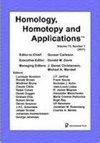An elementary proof of the chromatic Smith fixed point theorem
IF 0.5
4区 数学
Q2 MATHEMATICS
引用次数: 0
Abstract
A recent theorem by T. Barthel, M. Hausmann, N. Naumann, T. Nikolaus, J. Noel, and N. Stapleton says that if $A$ is a finite abelian $p$-group of rank $r$, then any finite $A$-space $X$ which is acyclic in the $n$th Morava $K$-theory with $n \geqslant r$ will have its subspace $X^A$ of fixed points acyclic in the $(n-r)$th Morava Ktheory. This is a chromatic homotopy version of P. A. Smith’s classical theorem that if $X$ is acyclic in mod p homology, then so is $X^A$. The main purpose of this paper is to give an elementary proof of this new theorem that uses minimal background, and follows, as much as possible, the reasoning in standard proofs of the classical theorem. We also give a new fixed point theorem for finite dimensional, but possibly infinite, $A\textrm{-CW}$ complexes, which suggests some open problems.色度史密斯定点定理的基本证明
T. Barthel、M. Hausmann、N. Naumann、T. Nikolaus、J. Noel 和 N. Stapleton 最近提出了一个定理。斯特普尔顿说,如果 $A$ 是一个秩为 $r$ 的有限无性 $p$ 群,那么任何在第 $n$th 莫拉瓦 $K$ 理论中具有 $n \geqslant r$ 的非循环性的有限 $A$ 空间 $X$ 都会在第 $(n-r)$th 莫拉瓦 K 理论中具有非循环性的定点子空间 $X^A$。这是 P. A. Smith 经典定理的色度同调版本,即如果 $X$ 在 mod p 同调中是非周期性的,那么 $X^A$ 也是非周期性的。本文的主要目的是给出这一新定理的基本证明,它使用了最少的背景知识,并尽可能遵循经典定理标准证明中的推理。我们还给出了有限维,但可能是无限维的 $A\textrm{-CW}$ 复数的新定点定理,并提出了一些有待解决的问题。
本文章由计算机程序翻译,如有差异,请以英文原文为准。
求助全文
约1分钟内获得全文
求助全文
来源期刊
CiteScore
1.10
自引率
0.00%
发文量
37
审稿时长
>12 weeks
期刊介绍:
Homology, Homotopy and Applications is a refereed journal which publishes high-quality papers in the general area of homotopy theory and algebraic topology, as well as applications of the ideas and results in this area. This means applications in the broadest possible sense, i.e. applications to other parts of mathematics such as number theory and algebraic geometry, as well as to areas outside of mathematics, such as computer science, physics, and statistics. Homotopy theory is also intended to be interpreted broadly, including algebraic K-theory, model categories, homotopy theory of varieties, etc. We particularly encourage innovative papers which point the way toward new applications of the subject.

 求助内容:
求助内容: 应助结果提醒方式:
应助结果提醒方式:


